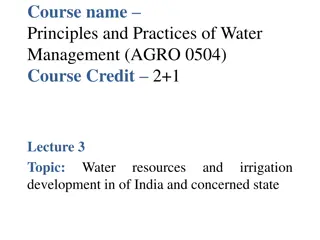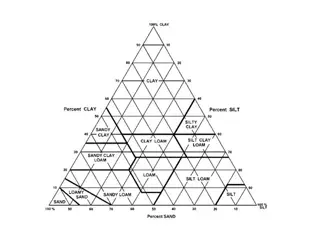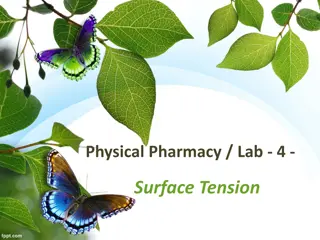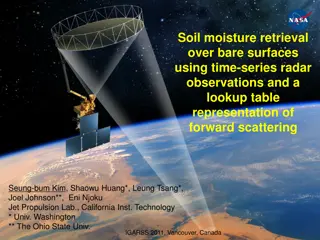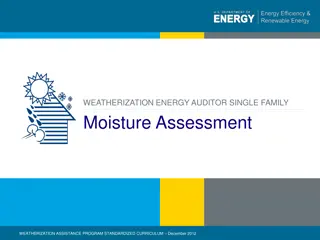Wireless Soil Moisture Tension Measurements for Irrigation Management
High-density, multiple-depth wireless soil moisture tension measurements were conducted in a vineyard in Napa Valley. The study found correlations between soil moisture tensions and leaf water potential, offering valuable insights for irrigation management. Utilizing a wireless sensor network, the system reduced labor costs and provided timely data for optimized irrigation practices.
Download Presentation

Please find below an Image/Link to download the presentation.
The content on the website is provided AS IS for your information and personal use only. It may not be sold, licensed, or shared on other websites without obtaining consent from the author.If you encounter any issues during the download, it is possible that the publisher has removed the file from their server.
You are allowed to download the files provided on this website for personal or commercial use, subject to the condition that they are used lawfully. All files are the property of their respective owners.
The content on the website is provided AS IS for your information and personal use only. It may not be sold, licensed, or shared on other websites without obtaining consent from the author.
E N D
Presentation Transcript
High Density, Multiple depth, Wireless Soil Moisture Tension Measurements for Irrigation Management Mark Holler, Owner, Vitaculturist, Camalie Vineyards, Mt. Veeder, Napa, Ca. mholler@pacbell.net, 650-799-6571 http://camalie.com
Abstract When sampled sufficiently at appropriate depths soil moisture tensions were found to correlate well with pressure chamber measurements of midday leaf water potential in Cabernet Sauvignon grape vines. Sampling 2-3 sites per acre across a 4.4 acre hillside vineyard produced a substantial correlation of midday leaf water potentials to soil moisture tensions at 24 depth; R2=.42. No correlation with soil moisture tensions measured at 12 depth was observed. The correlations were performed on soil moisture data and pressure chamber data from the 2007 irrigation season from a 4.4 acre Mt. Veeder hillside vineyard on the western slopes of Napa Valley. Soils in this vineyard are predominantly clay with a gradient of organic materials diffusing across the vineyard from an uphill forest watershed. Soil moisture data from Watermark soil moisture tensiometers at 10 monitoring sites was analyzed. The data suggests that soil moisture tension measurements may be able to replace many leaf water potential measurements which are significantly more labor intensive. A strategy for use of soil moisture tension measurements in managing regulated deficit irrigation of grape vines is presented. Monitoring of other irrigation system parameters using the Crossbow Eko-Pro self organizing wireless sensor network employed are also described.
Introduction Irrigation management in agriculture and landscaping is of growing importance as the growing global population puts more demand on finite fresh water and food supplies. Managing irrigation optimally improves yields, and quality, while reducing water use and pumping energy costs. Optimal irrigation management requires reliable knowledge of plant water stress and soil moisture status. Water transport in soil is often highly variable due to cracks and placement of the sensors relative to drippers and roots. When variance is high it is necessary to sample soil moistures at high spatial frequency to acquire enough data to make irrigation decisions with a desired confidence level. [13] This paper reports the application of a scalable soil moisture acquisition system to irrigation management. It reduces labor costs and presents more data in a more timely and integrated way to the irrigation manager. This new tool is wireless self organizing mesh networking [43-5] which provides data transport between sensors in the field and the irrigation manager on the internet. Correlation results indicate that soil moisture data can be used to augment or substitute for the much more labor intensive pressure chamber measurements and ET calculations commonly used in regulated deficit irrigation of grape vines. Soil moisture measurements at multiple depths provide insight into water transport downward in the soil which is useful for optimizing irrigation times and intervals between irrigations.
Vineyard Test Site 4.4 acre hillside vineyard located at 1000 ft. elevation in the Mt. Veeder appellation of Napa Valley. Generally deep clay soils but variable The vineyard is Cabernet Sauvignon French clones, 337,338 and 191. The vineyard was replanted in March of 2003. The 2007 growing season was the second year of production for this vineyard. Yield in 2007 more than doubled to 3.97 tons/acre from 1.81 tons/acre in 2006. The vineyard produced a yield of .9 tons/acre in 2005 when the vines were 2 years old. The 2007 yield is an all time record for this vineyard and high relative to most vineyards on Mt. Veeder. Grape quality was generally good but early rains just before harvest in mid October reduced sugar levels about 2 points after they peaked at 26.5-28 Brix on 10/13/07. Irrigation blocks and Soil Moisture Sampling Locations
Irrigation Paradigm The irrigation strategy used in this vineyard is based on regulated deficit irrigation as described in [1,2]. In this approach the vines are not irrigated at all until their midday leaf water potential reaches a threshold, in this case 13 Bar. After this threshold is reached water is applied at some fraction of the calculated evapo-transporation, typically 50% or 75% with leaf water potential monitored periodically to insure that the irrigations are producing the desired stress level. In this vineyard the approach was modified to maintain constant soil moisture after the threshold was reached rather than to apply water according to calculated ET from weather data and crop coefficients. The availability of real time soil moisture data made this approach possible. Occasional checks of leaf water potential were made to insure that the vine stress levels were not drifting from the threshold value. These measurements comprise the data correlations presented in this paper.
Soil Moisture Sensing Station Sensors at 12 and 24 depths Sub surface dripper tube outflow at 12 deep sensor Soil temp sensor also at 12 depth Solar powered network node tranceiver on stake 10 stations total, 2-3/irrigation block =2.3/acre
Irrigation System Monitors Line pressure sensors had sufficient resolution to indicate the fill level in a 10,000 gallon storage tank. The difference in pressure before and after the filter provided a good indication of the status of filter clogging. Another sensor monitored the availability of water from a neighbor s tank further up hill, water due under a water agreement.
Pressure Chamber Measurements Used standard PMS instrument. Midday Leaf water potentials ~ 2:00pm Leaves not bagged, measurements within 10 seconds of cuting Leaf water potentials were measured on 6 days distributed from June 19, 2007 to September 8, 2007. Measurements were made on leaves from the same 10 vines where soil moisture monitoring was taking place. See Figure 1 for locations. All measurements were made between irrigations when soil moisture values were changing relatively slowly, less than 5% per day.
Soil Moisture Trends Soil Moisture trend for whole growing season 2007 , 12 depth block 4, Dryer = higher values, low going transistions are irrigation events. Soil Moisture trend for 2008 thus far , 12 depth whole vineyard
Results/Discussion Correlations were done between leaf water potentials and soil moisture tensions acquired at 12 depth and 24 depth. Data from all locations and times were combined for these correlations. Sample size was 43 points per depth [14]. Points with soil moisture values more negative than 300cB were removed as most of these values were due to open connections. Least squares curve fits for each soil moisture measurement depth are shown in Figure 3. The soil moisture data at 12 depth does not correlate with the leaf water potential measurements but, at 24 depth there is a substantial [11] correlation with an R2 of .42. This data suggests that deeper placements of the soil moisture sensors might produce better correlations with the leaf water potentials. From this data one could also conclude that the vines were getting their water from deeper depths and that the vines have not concentrated their root growth around the sub surface dripper which is co-located with the soil moisture sensor at 12 depth. This information was useful in deciding not to move the subsurface drippers further from the vines or deeper to encourage root growth.
Discussion Irrigation in 2007 totaled 34 gallons/vine, reduced 26% from the 46 gallons/vine applied in 2006 including water used in fertigation early season and post harvest. Rainfall before the 2007 season was 16 compared to 40 for the 2006 season and the norm for this location. The 2007 season was sufficiently dry that water had to be trucked to the site to supply the last 20% of the water used during the season.
Soil Moisture vs. Leaf Water Potential Correlation -450 -400 Soil Moisture Tension (Centibar or kPa) -350 -300 -250 Figure 3 SM12 SM24 Linear (SM24) Linear (SM12) -200 R2 = 2E-07 -150 -100 -50 R2 = 0.42 0 -5 -10 -15 -20 0 Leaf Water Potential (Bar) Good correlation at 24 depth No correlation at 12 depth
Durations and Intervals In 2006 data from the soil moisture sensors was used to optimize irrigation durations and intervals. Soil moisture sensors provide good insight into how water moves within the soil hydraulic transport, something that leaf water potentials cannot provide. The delay between wetting at 12 depth and 24 depth is a measure of how long it takes water to move downward within the soil. From this the vertical hydraulic conductivity can be inferred. The slope of the drying transient indicates how fast water is is moving away from the sensors either due to diffusion or plant uptake. Irrigation durations and intervals were optimized to achieve a desired average soil moisture at 24 depth. This soil moisture target was based on leaf water potentials as described above. Total available water supply for the season was also considered. We adopted the premise that the vines benefit from reduced variability in soil moisture over time. The best uniformity over time would be achieved by very short durations at frequent intervals. Short durations and frequent intervals, however, do not allow the water to penetrate very far between irrigations. Short intervals also result in non-uniformities across each block because the line pressures are below spec for constant drip rate during start and stop transients. The total start up and shut down transient time for this irrigation system was determined to be about 30 minutes. We set the minimum irrigation duration to 2 hours to make the transient effects less than 25% of the irrigation duration. We then checked to see that the water was reaching the 24 deep sensors consistently with an interval equal to the time it took the 24 depth to dry out to the level before the last irrigation. The interval was then varied to bring the average soil moisture level at 24 depth to the target value. We then looked at the water consumption rate of our optimized duration/interval times and forecasted total use for the season. If this use was in excess of our water resource we lengthened the interval to the consumption rate we could afford. We then monitored the new average soil moisture and spot checked leaf water potentials to determine if we could keep the vines from becoming over stressed. If the leaf water potentials continue to drop to 15 bar and beyond as was the case in the 2007 season we purchased additional water and trucked it to the vineyard. In 2007 in light of a very dry winter rainfall we delayed irrigation until a higher stress level was achieved to reduce canopy growth and subsequent water consumption by the vines. Our yield and fruit maturity results suggests that this was a good approach. We feel that high water stress transients during the growing season can damage the vines not only in the short term but over several seasons as well.
Conclusions 24 deep soil moisture tension correlates well to leaf water potentials at Camalie Vineyards Soil Moisture tension measurements can be used to replace many or most pressure chamber measurements Soil Moistures are variable and require high spacial density sampling to make irrigation decisions; 2-3/irrigation block for irrigation blocks with relatively uniform soil/climate/slope/sun exposure. The general success of the 2007 growing season at this vineyard in terms of yield, ripeness and reduced water use supports the use of the modified regulated deficit irrigation but, indirectly because there are many other factors which affect yield and quality. Full paper in pdf format available at http://camalie.com/WirelessSensing/Correlation.htm
Acknowledgements My sincere thanks to Alan Broad and Rahul Kapur from Crossbow for providing support for the wireless network development. Ramon Pulido, vineyard manager for Camalie Vineyards, did the pruning, shoot thinning, spraying for powdery mildew, mowing, harvesting and all the other work involved in growing the grapes. His 30 years of experience growing grapes on Mt. Veeder has been invaluable. Thanks to Cynthia Bickerstaff for her guidance in statistical analysis of the data and for encouraging me to use Tobias Oetiker s RRDTOOLs shareware database and grapher which has made serving graphs of the data on the web simple. And finally thanks to Gary Bacon for invaluable help in creating this poster.
References [1] Hanson, B., Schwankl, L., and Fulton, A., 2004, Scheduling Irrigations: When and How Much Water to Apply, Water Management Handbook Series publication #3396, Department of Land Air and Water resources, University of California Davis. [2]Prichard, T., Wine Grape Irrigation Scheduling Using Deficit Irrigation Techniques [3] Shock, C., Barnum, J., Seddigh, M. 1998 Calibration of Watermark Soil Moisture Sensors for Irrigation Management. Proceedings of the International Irrigation Show, San Diego, 139-146 [4]Mainwaring, A., Polastre, J., Szewczyk, R., Culler, D., Wireless Sensor Networks for Habitat Monitoring, 2002 ACM International Workshop on Wireless Sensor Networks and Applications, Sept. 2002. [5]Zhao, F., Guibas, L., Wireless Sensor Networks, Morgan Kauffman , New York, 2004 [6] Lamm, F., Ayars, J., Nakayama, F., editors, Microirrigation for Crop Production, Design, Operation, Management, Developments in Agricultural Engineering 13, p 53. Elsevier, New York, 2007 [7]http://www.xbow.com/eko/ [8]Moisture Sensor Agricultural Irrigation Design Manual; http://www.irrometer.com/pdf/ADG.pdf [9]Watermark Soil Moisture Sensor, U.S. Patent #5179347 [10] Website of Camalie Vineyards, site of this experiment; http://camalie.com/






